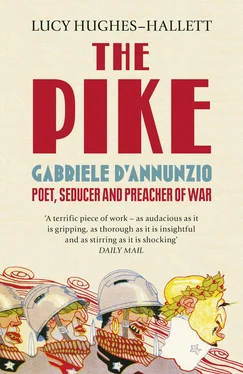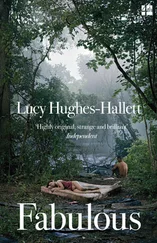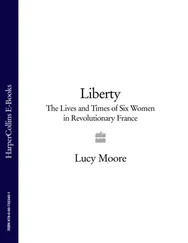His most-used pseudonym was a noble one, but there was a sad irony in the name Duke Minimo (least of the dukes). In one of the ‘Duke’s’ pieces he records how he and a group of friends have been refused access to a railway carriage. ‘We were repelled by main force, as though we were so many journalists.’ D’Annunzio was well aware how the person he actually was was viewed by the kind of person he aspired to be.
Andrea Sperelli, his fictional alter ego, lives in a huge, sumptuously decorated apartment in the Palazzo Zuccari, at the top of the Spanish Steps, around the corner from where d’Annunzio had rented one attic room next to a brothel. Elena Muti, d’Annunzio’s imaginary duchess, has an apartment in the Palazzo Barberini, where room after room is furnished with carved chests, classical busts, bronze platters and curtains embroidered with golden unicorns. D’Annunzio and his family lived in a cramped rented apartment in a narrow street nearby. In 1886 his second son, Gabriellino, was born. Veniero followed a year later. When Andrea Sperelli returns to his tapestry-hung rooms after a lunch party, he is at leisure to stretch languidly in front of his fire and muse on beauty and art until his manservant reminds him that it is time to dress for a dinner. His creator had deadlines to meet, bills to pay and, increasingly, creditors to placate. What he called the ‘miserable daily grind’ permitted him no respite.
Before going to a ball, Sperelli is invariably invited to dinner in one of Rome’s great palaces. D’Annunzio, by contrast, eating alone once in a beer shop, dozed off and dreamt of a ballroom all hung around with camellias and cradles. In each cradle there is a baby: each baby is crying loudly. The noise is excruciating. As the ballroom fills with couples, the gentlemen each take up several babies and attempt to dance while carrying them on their shoulders or under their armpits or beneath their waistcoats. The babies scream and wriggle, and poke their fingers into the dancer’s eyes, setting up such a hullabaloo that eventually the dreamer/writer awakes. It’s a dream that any exhausted new parent can identify with, that of a young father living in a small apartment with (at the time this piece was written) two children under the age of two and a half, striving to lead the exquisite life he so admired and coveted, but sleep-deprived and encumbered night and day by his offspring.
D’Annunzio’s need for money troubled him perhaps less than it ought to have done. Maria relates that, on receiving a fee desperately needed for the payment of household bills, he went ‘light and gay as a little bird’ to squander it all on a jade ornament. His compulsion to spend was at best reckless, at worst pathological.
He was not unmercenary. His correspondence demonstrates how much of his energy went into wheedling or browbeating his publishers into advancing him inordinately large sums against books as yet (and in some cases always to remain) unwritten. Once his novels were being published abroad, he studied exchange rates and timed his demands for the payments of his foreign royalties accordingly. When, in his famous middle age, he heard that a hotelier had, rather than banking his cheque, kept it for the sake of his autograph, he wondered if there was any way of persuading others to do likewise. But acquisitive as he was, he was also incorrigibly extravagant. While Maria, housekeeping for the first time in her hitherto privileged life, struggled to find cash for the butcher and baker, her husband allowed Sommaruga to pay him for his contributions to the Cronaca Bizantina with credit at the florist’s shop.
After two years at La Tribuna he wrote to the proprietor, Prince Maffeo Colonna di Sciarra, a letter which was in part a request for a pay rise, in part another literary self-portrait. ‘By temperament and by instinct I have a need for the superfluous.’ He must have beautiful things about him. ‘I could have lived very well in a modest house … taken tea in a threepenny cup, blown my nose on handkerchiefs at two lire the dozen … Instead, fatally, I have wanted Persian carpets, Japanese plates, bronzes, ivories, trinkets, all those useless, lovely things which I love with profound and ruinous passion.’ There is nothing apologetic about this self-description. An archangel cannot be expected to match his expenditure to the means available, after the manner of a penny-pinching tradesman. Nor can one of those superior beings whose role it is to ‘think and feel’. Prodigality is an aristocratic vice, a perverted form of largesse. Besides, d’Annunzio was not simply a self-indulgent squanderer (although he was that too). He was, in the most literal meaning of the word, an aesthete, one for whom the cult of beauty took the place of morality.
Writing art reviews and journalistic essays, d’Annunzio was pleased to be following the lead given by Baudelaire in the previous generation. The author of Les Fleurs du mal was also an influential art critic, and his essay on the ‘dandy’ defined a new kind of hero. ‘These beings have no other aim, but that of cultivating the idea of beauty in their own persons, of satisfying their passions, of feeling and thinking.’ Baudelaire had many followers among the French Decadents and Symbolists whom d’Annunzio was reading greedily – Théophile Gautier, Henri Régnier, Stéphane Mallarmé. In 1882, d’Annunzio’s first year in Rome, Walter Pater, whom d’Annunzio had read with Nencioni, visited the city for the first time, subsequently writing Marius the Epicurean, a novel in which homoerotic fantasy entwines itself around philosophical musings. Meanwhile Oscar Wilde, who called Pater’s essays ‘the holy writ of beauty’, was touring the United States. There Wilde, in velvet frock coat and satin breeches, lectured on the ‘House Beautiful’, not so much a style of interior decoration as an aspiration closely parallel to the d’Annunzian injunction that a life must be made in the same way as a work of art.
That beautiful life was at once ancient and modern. ‘All the literature of the present day is abject rubbish,’ wrote Giosuè Carducci. ‘Let us return then to true art, to the Greeks and the Latins. What ridiculous little dwarfs are these Italian realists!’ D’Annunzio had been one of those dwarfs, but the poems written during the first year and a half of his marriage, which would be published under the collective titles of La Chimera (pseudo-classical) and Isaotta Guttadauro (pseudo-mediaeval), are newly written examples of centuries-old verse-forms. Their words are archaic, their imagery (lilies, pomegranates, ailing damozels) is pre-Raphaelite. Their rhyme-schemes are tight, their rhythms song-like. Jewels and flowers heavy with erotic symbolism are disposed around the figures of noble maidens and their knightly suitors. Even the spelling is pseudo-antique. Soon after the publication of Isaotta Guttadauro a parody appeared, entitled Risaotto al Pomidauro (tomato risotto – spelt in an equally faked-up olde-worlde manner).
Scarfoglio had published the parody. D’Annunzio, ostensibly deeply offended, challenged him to a duel, which took place without injury to either party. It was widely suspected that (like the spat with Sommaruga over the ‘obscene’ jacket illustration) the parody, challenge and duel had been got up between the two friends as a way of drawing attention to the poems.

ELITISM
IN SEPTEMBER 1885, d’Annunzio quarrelled with a journalist, Carlo Magnico, and challenged him to a duel. At school d’Annunzio had been a prize-winning fencer. In Rome he had kept himself in training, but Magnico, who had the advantage of being considerably taller, bested him. D’Annunzio received a wound to the head, only a shallow cut, but it rattled him. (Pleasure’s hero comes close to being killed in a duel.) The writer and editor Mathilde Serao was present at the fight. She relates that the doctor, alarmed by the amount of blood d’Annunzio was losing, poured iron perchlorate over the wound. The bleeding was staunched, but the chemical did irreparable damage to d’Annunzio’s hair follicles – or so Serao, perhaps prompted by d’Annunzio, maintained. Soon afterwards he was bald.
Читать дальше













